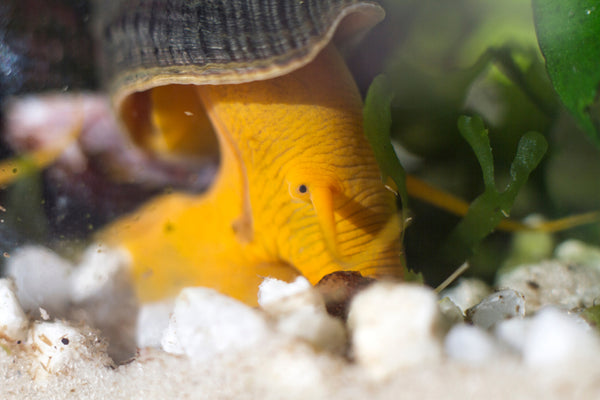Freshwater snails make excellent additions to community tanks, planted tanks, and even shrimp tanks. The trouble with many freshwater snails, however, is that they reproduce quickly and can easily take over a tank in a matter of months. The rabbit snail (Tylomelania gemmifera) is unique, not only in its slow rate of reproduction but in its intriguing appearance.
In this guide, you’ll learn the basics about rabbit snail species, how to care for them, and how to ensure they thrive as part of your freshwater environment.
Species Snapshot
- Species Name: Tylomelania gemmifera
- Common Names: rabbit snail, elephant snail, poso snail
- Size: Up to 5 inches
- Lifespan: About 3 years
- Native Distribution: Sulawesi, Indonesia
Compared to the ever-popular nerite snail and mystery snail, rabbit snail species have an exotic appearance. They have long, cone-shaped shells and their bodies are often brightly colored. Rabbit snails resemble Malaysian trumpet snails with their conical shells, but they’re easily distinguished by the two antennae on their heads that look like rabbit ears. These snails also have an elephant-like snout.
Rabbit snails generally grow to a maximum of 3 inches, though some rabbit snail species remain small, around 1.5 inches. With proper care, they can live for 3 years or more. Let’s take a look at some of the most popular rabbit snail species.
7 Rabbit Snail Species
The scientific name Tylomelania gemmifera is usually used in reference to the rabbit snail, though the Tylomelania genus itself contains more than 30 species. Rabbit snails are endemic to Sulawesi, one of the main islands of Indonesia. Here’s a quick overview of some of the different varieties:
- Golden Rabbit Snail (Tylomelania gemmifera) – Named for its golden-yellow body, these snails have dark brown or black shells with 9 to 10 whorls.
- Orange Poso (Tylomelania zemis) – This species exhibits a bright orange coloration with a dark brown or black shell. Orange poso snails can reach five inches long.
- Yellow Poso (Tylomelania zemis) – A selectively bred variety of the orange poso, this snail has a yellow body and either a dark brown or mixed light-and-dark shell.
- Chocolate Rabbit Snail (Tylomelania perfecta) – These rabbit snails exhibit a chocolate brown body coloration and sandy shell color.
- Black Rabbit Snail – A rare variety with an unknown species name, the black rabbit snail has a black body and matching black shell.
- White Spotted Rabbit Snail (Tylomelania patriarchalis) – This species has a salt-and-pepper coloration—a black body dotted with tiny white spots. Their shells come in various shades of brown, red, and white.
- Gold Spotted Rabbit Snail (Tylomelania towutensis) – Similar to the previous variety, these rabbit snails have dark bodies dotted with golden yellow spots. Their shells are mixed with shades of brown, black, and yellow.
What makes the rabbit snail unique is its long, conical shell that comes to a fine point. The width of the shell varies across species, though all species have an operculum which allows them to retract into their shell and cover the opening. Most rabbit snail species have 5 to 7 whorls or twists on their shells, though some have as many as 10.

Setting Up the Ideal Environment
Rabbit snails can grow fairly large, though most of their size is taken up by their shell. Even so, they are eager eaters and will need plenty of food to thrive. Because rabbit snails are scavengers, they’ll feed on algae, biofilm, decaying plant matter, and other detritus in the tank. The larger your tank, the more natural food sources it is likely to provide.
The minimum recommended tank size for rabbit snails is 30 gallons. Planted tanks are ideal with decorations consisting of driftwood and rockwork. Use soft substrate in your tank because rabbit snails like to burrow occasionally.
Like many freshwater snails, rabbit snail species are adaptable to various water parameters. Because they’re native to Indonesia, however, they’re most likely to thrive in tropical conditions. Aim for a tank temperature between 72°F and 75°F with a pH of 7.0 to 8.5 and hardness between 4 and 12 dGH. Water flow doesn’t need to be strong, but filtration is wise to maintain a healthy biological filter in the tank.
Tips for Care and Breeding
Rabbit snails are peaceful creatures but that doesn’t mean they’re boring. In fact, they can be quite active, and they love to explore their tank. It’s wise to keep a tight lid on your tank because rabbit snails have been known to escape and wander off.
With their peaceful demeanor, rabbit snails make excellent addition to the freshwater community tank—provided the inhabitants aren’t too big. Large cichlids and goldfish may prey on rabbit snails while smaller fish like gouramis, tetras, danios, rasboras, and livebearers are unlikely to bother them. Rabbit snails can also be kept with freshwater shrimp and other snails.
If you plan to keep several rabbit snails together, be prepared for them to breed. Fortunately, however, they reproduce slowly, having just one or two baby snails per breeding cycle. To breed, the male rabbit snail passes sperm to the female who retains it until she’s ready to release an egg. The fertilized egg then goes through a short incubation period before emerging as a fully formed but miniature rabbit snail.
Caring for baby rabbit snails is no different than adults. These snails will find plenty to eat in a mature planted aquarium, though it may sometimes be necessary to supplement their diet with sinking pellets, algae wafers, and blanched vegetables. Remove any uneaten food after a few hours to keep it from breaking down and spiking the ammonia level in your tank.
Whether you’re setting up a new tank or looking for a unique addition to an existing tank, consider the rabbit snail from Shrimpy Business. With a wide range of colorful varieties to choose from, these beautiful creatures deserve a showcase spot in your tank.
